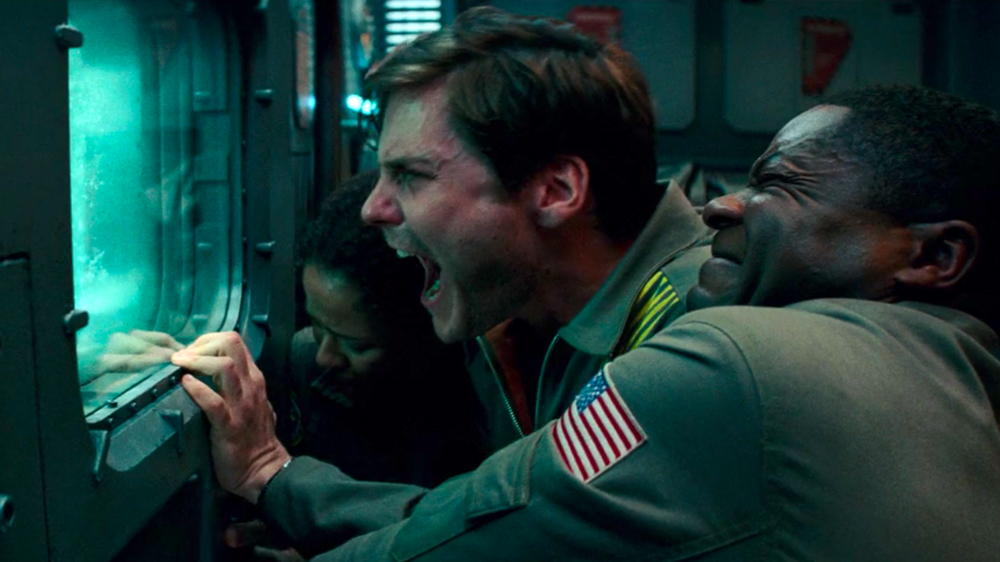There was nothing utterly remarkable about it, though it was a fun, albeit disorienting, found footage thriller. Perhaps the best thing about the first movie was probably it’s clandestine approach to marketing. Before “Cloverfield” was released, the only thing we knew about the movie was from the very vague teaser trailer and the poster featuring a headless Lady Liberty. When I first heard about the sequel, “10 Cloverfield Lane”, I believed it to be completely unnecessary, but upon seeing it, I was pleased to find it was superior to its predecessor. Ditching the found footage gimmick worked wonders for them, the script was tight and tense, and I thought John Goodman completely reinvented himself for his role in that film. The film had resuscitated a franchise that had lay cold and abandoned for the better part of a decade. So when I heard that they were doing a third Cloverfield movie, my ears perked up; I was intrigued. I wondered if they could top the second film, or if, perhaps, this film would be a sign that Hollywood should let this beast die in peace.
My verdict after watching: maybe let the franchise die. It deserves some dignity.
That is not to say that there isn’t some good here; there is. The special effects won’t win any awards, but they don’t look as bad as some things I’ve seen of late; the acting, done by an A- and B-list cast, is absolutely fine (there’s that word again: fine). Chris O'Dowd is the most likeable character, though his comic relief is frequently out of place. That’s about the extent of the good, however. There are many, many problems with “Paradox”, but the biggest issues are the writing, which is repetitive and sophomoric, and the story, which is utterly ridiculous, and filled with plot and loopholes. I thought about tagging spoilers throughout, but really there are so many ludicrous twists that it’d be hard to write a review without spoiling some things. In lieu of spoiler tags, I’m just letting you know that spoilers follow. You’ve been warned.
Hamilton (Gugu Mbatha-Raw, “Beauty and the Beast (2017)”) and her husband Michael (Roger Davies) wait in a long line at a gas station. There is an energy crisis on earth, and several countries, specifically Russia and Germany, are on the brink of war. It’s revealed that Hamilton is going to head up into space to be part of a team that will experiment with the Sheppard Particle Accelerator, which, if successful, could provide energy for the world indefinitely. Flash forward two years, and Hamilton is up in the space station with other scientists, still trying to figure out how to make this particle accelerator work. Among the crew are Schmidt (Daniel Bruhl, “Captain America: Civil War”), Mundy (Chris O’Dowd, “Bridesmaids”), Kiel (David Oyelowo, “Gringo”), Volkov (Aksel Hennie, “The Martian”), and Monk (John Ortiz, “Kong: Skull Island”). Plenty of fodder for the slaughter to come…
Hamilton talks to her husband on Earth through a telecom channel, telling him they only have enough fuel for a few more tests. It’s a bittersweet predicament. Hamilton misses her husband, but knows the work they’re doing in space could be important. The crewmembers go about preparing the next experiment while the news plays in the background. A harbinger warns, in lengthy expositional dialogue, that the experiments could open portals to different dimensions. The man warns that aliens, monster, or demons could come through this portal, but it could also rupture the space-time continuum, meaning that what they’re doing could not only affect the present, but the past and future as well… Perhaps the greatest part of the Cloverfield franchise was that the origin of the creature was shrouded in secrecy. The beast was like Lovecraft’s Cthulhu and the Great Old Ones; terrifying because we could not truly grasp what they were. By explaining where the monster comes from, the creators of the monster have effectively killed that murky mythos, and they’ve done so in a way that makes the beast seem cheesy. This was also the first place I laughed out loud, but don’t worry, there are plenty of other far-fetched ideas to come.
They crew members start the experiment and the ship shudders as the particle accelerator actually begins to work, but then there is a surge of power and crew members have to rush around to put out fires. After this is done, the crewmembers try to get their bearings but are shocked to discover they are no longer orbiting Earth. They hear screaming coming from behind a wall, and without a logical explanation, they open the wall panel to reveal a woman (Elizabeth Debicki, “Widows”) trapped inside, skewered by the inner wires and metal workings. She looks directly at Hamilton and says her name; the delivery is dripping with melodrama, and instead of bringing tension it instead prompted more laughs from my roommates and myself.
Meanwhile, Hamilton’s husband Michael awakens back on Earth to an explosion. He checks his phone and realizes that something horrible has happened, but nobody has an explanation as to what it is specifically. He decides to go to help the victims. How is he going to help the victims? Why is he charging headfirst into a danger zone like a deranged Kenny Loggins? Who knows, but it progresses the plot, so who really cares, right? Michael’s subplot is crudely stitched in throughout the film; every time we break from the space station to rejoin him on Earth, the scenes feel completely unnecessary and out of place. His storyline added nothing, in my personal opinion; they could’ve cut twenty minutes from the film and saved us all some time.








